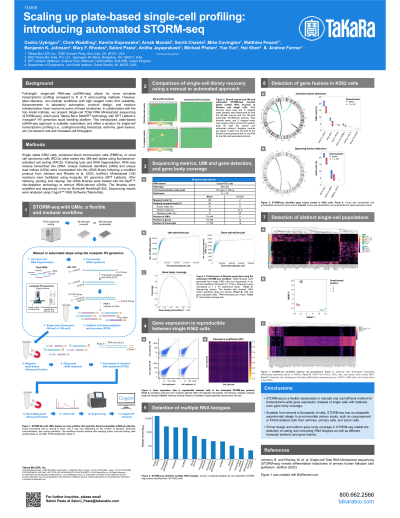Frontiers in Technology
Poster Session B
(1149-B) Scaling up plate-based single-cell profiling: introducing automated STORM-seq
Wednesday, May 29, 2024
10:30 - 11:15 CEST
Location: Exhibit Hall

- MP
Matthieu Pesant, PhD
Senior Market Strategy Manager, Translational Genomics
Takara Bio Europe
Saint-Germain-en-Laye, Ile-de-France, France
Poster Presenter(s)
Abstract:
Background:
Unlike 3’ or 5’ end-counting methods, total full-length single-cell RNA-seq (scRNA-seq) allows for complete cellular profiling. However, labor-intensive, non-modular workflows with high reagent costs limit functionality and scalability. Advancements in laboratory automation, protocol design, and reaction miniaturization have overcome many limitations. In collaboration with the Van Andel Institute, we present Single-cell TOtal RNA Miniaturized sequencing (STORM-seq), which pairs Takara Bio’s SMART® technology with SPT Labtech’s mosquito® HV genomics liquid handling platform. This miniaturized, plate-based scRNA-seq approach is scalable, automated, and offers a solution for complete single-cell transcriptomic profiling (i.e., coding/noncoding transcripts, isoforms, gene fusions, etc.) at reduced cost and increased cell throughput.
Methods:
Single viable K562, Jurkat, peripheral blood mononuclear cells (PMBCs), or renal cell carcinoma cells were sorted into 384-well plates using fluorescence-activated cell sorting (FACS). Following lysis and RNA fragmentation, RNA was reverse transcribed into cDNA, and unique molecular identifiers (UMIs) and unique dual indices (UDIs) were incorporated into the cDNA library following a modified protocol from Johnson and Rhodes et al. (2022, bioRxiv). Miniaturized (1/6) reactions were facilitated using mosquito HV genomics (SPT Labtech). After indexing, pooling, and cleanup, the cDNA libraries were treated with the ZapR™ ribo-depletion technology to remove rRNA-derived cDNAs. The libraries were then amplified and sequenced on an Illumina® NextSeq® 500. Sequencing results were analyzed using Cogent™ NGS Software (Takara Bio).
Results:
STORM-seq increased the throughput and flexibility of plate-based scRNA-seq by enabling the use of either 96- or 384-well plates. Validation of STORM-seq on mosquito HV genomics demonstrated improved sensitivity and reproducibility while reducing hands-on time. The approach allowed for >95% recovery of libraries in a highly reproducible manner. At >98% strand specificity, the approach achieved ~98% mapping rates, of which >70% were from exonic reads. STORM-seq generated high complexity libraries, saturating at >60,000 UMIs and >10,000 genes detected with uniform gene body coverage, facilitating accurate gene detection. The full transcript coverage enabled the detection of multiple RNA biotypes, ranging from miRNA, snRNA, and non-coding transcripts (lncRNA and lincRNA) known to regulate gene expression. Comprehensive data generated using Cogent™ NGS Software allowed for gene fusion detection, such as BCR-ABL1 fusions in the K562 cells. Furthermore, we demonstrated the versatility of STORM-seq by identifying distinct cell types from heterogeneous PBMC and dissociated renal cell carcinoma samples.
Conclusion:
STORM-seq is miniaturized, incorporates UMIs, and provides flexibility for users, as the protocol is automation-friendly or can be executed manually. The addition of mosquito HV genomics further enhances the efficiency and scalability of the STORM-seq approach. When paired with Cogent NGS Software, STORM-seq provides a complete solution that enables in-depth transcriptomic profiling at unprecedented resolution. The increased throughput, modularity, and cost-effectiveness make STORM-seq a valuable tool for researchers in the genomics and transcriptomics fields.
Background:
Unlike 3’ or 5’ end-counting methods, total full-length single-cell RNA-seq (scRNA-seq) allows for complete cellular profiling. However, labor-intensive, non-modular workflows with high reagent costs limit functionality and scalability. Advancements in laboratory automation, protocol design, and reaction miniaturization have overcome many limitations. In collaboration with the Van Andel Institute, we present Single-cell TOtal RNA Miniaturized sequencing (STORM-seq), which pairs Takara Bio’s SMART® technology with SPT Labtech’s mosquito® HV genomics liquid handling platform. This miniaturized, plate-based scRNA-seq approach is scalable, automated, and offers a solution for complete single-cell transcriptomic profiling (i.e., coding/noncoding transcripts, isoforms, gene fusions, etc.) at reduced cost and increased cell throughput.
Methods:
Single viable K562, Jurkat, peripheral blood mononuclear cells (PMBCs), or renal cell carcinoma cells were sorted into 384-well plates using fluorescence-activated cell sorting (FACS). Following lysis and RNA fragmentation, RNA was reverse transcribed into cDNA, and unique molecular identifiers (UMIs) and unique dual indices (UDIs) were incorporated into the cDNA library following a modified protocol from Johnson and Rhodes et al. (2022, bioRxiv). Miniaturized (1/6) reactions were facilitated using mosquito HV genomics (SPT Labtech). After indexing, pooling, and cleanup, the cDNA libraries were treated with the ZapR™ ribo-depletion technology to remove rRNA-derived cDNAs. The libraries were then amplified and sequenced on an Illumina® NextSeq® 500. Sequencing results were analyzed using Cogent™ NGS Software (Takara Bio).
Results:
STORM-seq increased the throughput and flexibility of plate-based scRNA-seq by enabling the use of either 96- or 384-well plates. Validation of STORM-seq on mosquito HV genomics demonstrated improved sensitivity and reproducibility while reducing hands-on time. The approach allowed for >95% recovery of libraries in a highly reproducible manner. At >98% strand specificity, the approach achieved ~98% mapping rates, of which >70% were from exonic reads. STORM-seq generated high complexity libraries, saturating at >60,000 UMIs and >10,000 genes detected with uniform gene body coverage, facilitating accurate gene detection. The full transcript coverage enabled the detection of multiple RNA biotypes, ranging from miRNA, snRNA, and non-coding transcripts (lncRNA and lincRNA) known to regulate gene expression. Comprehensive data generated using Cogent™ NGS Software allowed for gene fusion detection, such as BCR-ABL1 fusions in the K562 cells. Furthermore, we demonstrated the versatility of STORM-seq by identifying distinct cell types from heterogeneous PBMC and dissociated renal cell carcinoma samples.
Conclusion:
STORM-seq is miniaturized, incorporates UMIs, and provides flexibility for users, as the protocol is automation-friendly or can be executed manually. The addition of mosquito HV genomics further enhances the efficiency and scalability of the STORM-seq approach. When paired with Cogent NGS Software, STORM-seq provides a complete solution that enables in-depth transcriptomic profiling at unprecedented resolution. The increased throughput, modularity, and cost-effectiveness make STORM-seq a valuable tool for researchers in the genomics and transcriptomics fields.
